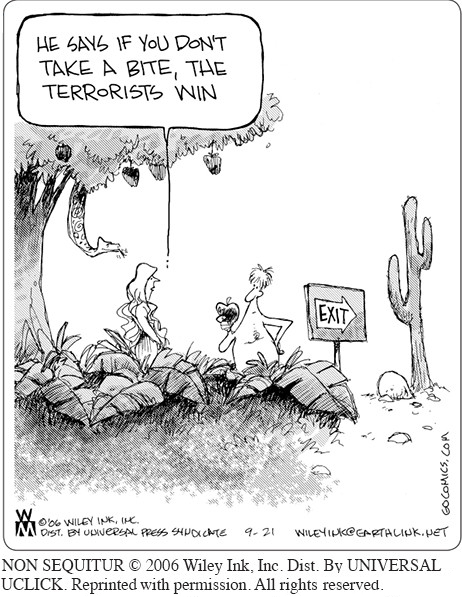Recognizing Logical Fallacies
When you write arguments in college, you follow certain rules that ensure fairness. Not everyone who writes arguments is fair or thorough, however. Sometimes you will encounter arguments in which writers attack the opposition’s intelligence or patriotism and base their arguments on questionable (or even false) assumptions. As convincing as these arguments can sometimes seem, they are not valid because they contain fallacies—errors in reasoning that undermine the logic of an argument. Familiarizing yourself with the most common logical fallacies can help you to evaluate the arguments of others and to construct better, more effective arguments of your own.
The following pages define and illustrate some logical fallacies that you should learn to recognize and avoid.
Begging the Question
The fallacy of begging the question assumes that a statement is self-
| MAJOR PREMISE | Everything in the Bible is true. |
| MINOR PREMISE | The Bible says that Noah built an ark. |
| CONCLUSION | Therefore, Noah’s Ark really existed. |
A person can accept the conclusion of this syllogism only if he or she also accepts the major premise, which has not been proven true. Some people might find this line of reasoning convincing, but others would not—
Begging the question occurs any time someone presents a debatable statement as if it were true. For example, look at the following statement:
You have unfairly limited my right of free speech by refusing to print my editorial in the college newspaper.
This statement begs the question because it assumes what it should be proving—
Circular Reasoning
Closely related to begging the question, circular reasoning occurs when someone supports a statement by restating it in different terms. Consider the following statement:
Stealing is wrong because it is illegal.
Page 148
The conclusion of the statement on the previous page is essentially the same as its beginning: stealing (which is illegal) is against the law. In other words, the argument goes in a circle.

Here are some other examples of circular reasoning:
Lincoln was a great president because he is the best president we ever had.
I am for equal rights for women because I am a feminist.
Illegal immigrants should be deported because they are breaking the law.
All of the statements above have one thing in common: they attempt to support a statement by simply repeating the statement in different words.
Weak Analogy
An analogy is a comparison between two items (or concepts)—one familiar and one unfamiliar. When you make an analogy, you explain the unfamiliar item by comparing it to the familiar item.
Although analogies can be effective in arguments, they have limitations. For example, a senator who opposed a government bailout of the financial industry in 2008 made the following argument:
This bailout is doomed from the start. It’s like pouring milk into a leaking bucket. As long as you keep pouring milk, the bucket stays full. But when you stop, the milk runs out the hole in the bottom of the bucket. What we’re doing is throwing money into a big bucket and not fixing the hole. We have to find the underlying problems that have caused this part of our economy to get in trouble and pass legislation to solve them.
The problem with using analogies such as this one is that analogies are never perfect. There is always a difference between the two things being compared. The larger this difference, the weaker the analogy—
Page 149
Ad Hominem Fallacy (Personal Attack)

The ad hominem fallacy occurs when someone attacks the character or the motives of a person instead of focusing on the issues. This line of reasoning is illogical because it focuses attention on the person making the argument, sidestepping the argument itself.
Consider the following statement:
Dr. Thomson, I’m not sure why we should believe anything you have to say about this community health center. Last year, you left your husband for another man.
The above attack on Dr. Thomson’s character is irrelevant; it has nothing to do with her ideas about the community health center. Sometimes, however, a person’s character may have a direct relation to the issue. For example, if Dr. Thomson had invested in a company that supplied medical equipment to the health center, this fact would have been relevant to the issue at hand.
The ad hominem fallacy also occurs when you attempt to undermine an argument by associating it with individuals who are easily attacked. For example, consider this statement:
I think your plan to provide universal heath care is interesting. I’m sure Marx and Lenin would agree with you.
Instead of focusing on the specific provisions of the health-
Creating a Straw Man
This fallacy most likely got its name from the use of straw dummies in military and boxing training. When writers create a straw man, they present a weak argument that can easily be refuted. Instead of attacking the real issue, they focus on a weaker issue and give the impression that they have effectively refuted an opponent’s argument. Frequently, the straw man is an extreme or oversimplified version of the opponent’s actual position. For example, during a debate about raising the minimum wage, a senator made the following comment:
Those who oppose raising the minimum wage are heartless. They obviously don’t care if children starve.
Page 150

Instead of focusing on the minimum wage, the senator misrepresents the opposing position so that it appears cruel. As this example shows, the straw man fallacy is dishonest because it intentionally distorts an opponent’s position to mislead readers.
Hasty or Sweeping Generalization (Jumping to a Conclusion)
A hasty or sweeping generalization (also called jumping to a conclusion) occurs when someone reaches a conclusion that is based on too little evidence. Many people commit this fallacy without realizing it. For example, when Richard Nixon was elected president in 1972, film critic Pauline Kael is supposed to have remarked, “How can that be? No one I know voted for Nixon!” The general idea behind this statement is that if Kael’s acquaintances didn’t vote for Nixon, then neither did most other people. This assumption is flawed because it is based on a small sample.
Sometimes people make hasty generalizations because they strongly favor one point of view over another. At other times, a hasty generalization is simply the result of sloppy thinking. For example, it is easier for a student to simply say that an instructor is an unusually hard grader than to survey the instructor’s classes to see if this conclusion is warranted (or to consider other reasons for his or her poor performance in a course).
Page 151
Either/Or Fallacy (False Dilemma)
The either/or fallacy (also called a false dilemma) occurs when a person says that there are just two choices when there are actually more. In many cases, the person committing this fallacy tries to force a conclusion by presenting just two choices, one of which is clearly more desirable than the other. (Parents do this with young children all the time: “Eat your carrots, or go to bed.”)
Politicians frequently engage in this fallacy. For example, according to some politicians, you are either pro-
Consider the following statement:
I can’t believe you voted against the bill to build a wall along the southern border of the United States. Either you’re for protecting our border, or you’re against it.
This statement is an example of the either/or fallacy. The person who voted against the bill might be against the wall but not against all immigration restrictions. The person might favor loose restrictions for some people (for example, migrant workers) and strong restrictions for others (for example, drug smugglers). By limiting the options to just two, the speaker oversimplifies the situation and attempts to force the listener to accept a fallacious argument.

Page 152
Equivocation
The fallacy of equivocation occurs when a key term has one meaning in one part of an argument and another meaning in another part. (When a term is used unequivocally, it has the same meaning throughout the argument.) Consider the following old joke:
The sign said, “Fine for parking here,” so because it was fine, I parked there.
Obviously, the word fine has two different meanings in this sentence. The first time it is used, it means “money paid as a penalty.” The second time, it means “good” or “satisfactory.”
Most words have more than one meaning, so it is important not to confuse the various meanings. For an argument to work, a key term has to have the same meaning every time it appears in the argument. If the meaning shifts during the course of the argument, then the argument cannot be sound.
Consider the following statement:
This is supposed to be a free country, but nothing worth having is ever free.
In this statement, the meaning of a key term shifts. The first time the word free is used, it means “not under the control of another.” The second time, it means “without charge.”
Red Herring
This fallacy gets its name from the practice of dragging a smoked fish across the trail of a fox to mask its scent during a fox hunt. As a result, the hounds lose the scent and are thrown off the track. The red herring fallacy occurs when a person raises an irrelevant side issue to divert attention from the real issue. Used skillfully, this fallacy can distract an audience and change the focus of an argument.
Political campaigns are good sources of examples of the red herring fallacy. Consider this example from the 2016 presidential race:
I know that Donald Trump says that he is for the “little guy,” but he lives in a three-
The focus of his argument should have been on Trump’s policies, not on the fact that he lives in a penthouse.
Here is another red herring fallacy from the 2016 political campaign:
Page 153

Hillary Clinton wants us to vote for her, but she will be sixty-
Again, the focus of these remarks should have been on Clinton’s qualifications, not on her age.
Slippery Slope

The slippery-
We encounter examples of the slippery-
If we allow gay marriage, then there is nothing to stop polygamy. And once we allow this, where will it stop? Will we have to legalize incest—
Whether or not you support same-
Page 154
You Also (Tu Quoque)
The you also fallacy asserts that a statement is false because it is inconsistent with what the speaker has said or done. In other words, a person is attacked for doing what he or she is arguing against. Parents often encounter this fallacy when they argue with their teenage children. By introducing an irrelevant point—
How can you tell me not to smoke when you used to smoke?
Don’t yell at me for drinking. I bet you had a few beers before you were twenty-
one. Why do I have to be home by midnight? Didn’t you stay out late when you were my age?
Arguments such as these are irrelevant. People fail to follow their own advice, but that does not mean that their points have no merit. (Of course, not following their own advice does undermine their credibility.)
Appeal to Doubtful Authority
Writers of research papers frequently use the ideas of recognized authorities to strengthen their arguments. However, the sources offered as evidence need to be both respected and credible. The appeal to doubtful authority occurs when people use the ideas of nonexperts to support their arguments.
Not everyone who speaks as an expert is actually an authority on a particular issue. For example, when movie stars or recording artists give their opinions about politics, climate change, or foreign affairs—
How do you determine whether a person you read about or hear is really an authority? First, make sure that the person actually has expertise in the field he or she is discussing. You can do this by checking his or her credentials on the Internet. Second, make sure that the person is not biased. No one is entirely free from bias, but the bias should not be so extreme that it undermines the person’s authority. Finally, make sure that you can confirm what the so-
Page 155

Misuse of Statistics
The misuse of statistics occurs when data are misrepresented. Statistics can be used persuasively in an argument, but sometimes they are distorted—
Misleading statistics can be much subtler (and much more complicated) than the example above. For example, one year, there were 16,653 alcohol-
Page 156
Post Hoc, Ergo Propter Hoc (After This, Therefore Because of This)
The post hoc fallacy asserts that because two events occur closely in time, one event must cause the other. Professional athletes commit the post hoc fallacy all the time. For example, one major league pitcher wears the same shirt every time he has an important game. Because he has won several big games while wearing this shirt, he believes it brings him luck.
Many events seem to follow a sequential pattern even though they actually do not. For example, some people refuse to get a flu shot because they say that the last time they got one, they came down with the flu. Even though there is no scientific basis for this link, many people insist that it is true. (The more probable explanation for this situation is that the flu vaccination takes at least two weeks to take effect, so it is possible for someone to be infected by the flu virus before the vaccine starts working.)
Page 157
Another health-
Non Sequitur (It Does Not Follow)
The non sequitur fallacy occurs when a conclusion does not follow from the premises. Frequently, the conclusion is supported by weak or irrelevant evidence—
Megan drives an expensive car, so she must be earning a lot of money.
Megan might drive an expensive car, but this is not evidence that she has a high salary. She could, for example, be leasing the car or paying it off over a five-
Non sequiturs are common in political arguments. Consider this statement:
Gangs, drugs, and extreme violence plague today’s prisons. The only way to address this issue is to release all nonviolent offenders as soon as possible.
This assessment of the prison system may be accurate, but it doesn’t follow that because of this situation, all nonviolent offenders should be released immediately.
Scientific arguments also contain non sequiturs. Consider the following statement that was made during a debate on climate change:
Recently, the polar ice caps have thickened, and the temperature of the oceans has stabilized. Obviously, we don’t need to do more to address climate change.
Page 158

Even if you accept the facts of this argument, you need to see more evidence before you can conclude that no action against climate change is necessary. For example, the cooling trend could be temporary, or other areas of the earth could still be growing warmer.
Bandwagon Fallacy
The bandwagon fallacy occurs when you try to convince people that something is true because it is widely held to be true. It is easy to see the problem with this line of reasoning. Hundreds of years ago, most people believed that the sun revolved around the earth and that the earth was flat. As we know, the fact that many people held these beliefs did not make them true.
Page 159
The underlying assumption of the bandwagon fallacy is that the more people who believe something, the more likely it is to be true. Without supporting evidence, however, this form of argument cannot be valid. For example, consider the following statement made by a driver who was stopped by the police for speeding:
Officer, I didn’t do anything wrong. Everyone around me was going the same speed.
As the police officer was quick to point out, the driver’s argument missed the point: he was doing fifty-
Page 160
Since most people want to go along with the crowd, the bandwagon fallacy can be very effective. For this reason, advertisers use it all the time. For example, a book publisher will say that a book has been on the New York Times bestseller list for ten weeks, and a pharmaceutical company will say that its brand of aspirin outsells other brands four to one. These appeals are irrelevant, however, because they don’t address the central questions: Is the book actually worth reading? Is one brand of aspirin really better than other brands?
EXERCISE 5.10
Determine which of the following statements are logical arguments and which are fallacies. If the statement is not logical, identify the fallacy that best applies.
Almost all the students I talked to said that they didn’t like the senator. I’m sure he’ll lose the election on Tuesday.
This car has a noisy engine; therefore, it must create a lot of pollution.
I don’t know how Professor Resnick can be such a hard grader. He’s always late for class.
A vote for the bill to limit gun sales in the city is a vote against the Second Amendment.
It’s only fair to pay your fair share of taxes.
I had an internship at a government agency last summer, and no one there worked very hard. Government workers are lazy.
It’s a clear principle of law that people are not allowed to yell “Fire!” in a crowded theater. By permitting protestors to hold a rally downtown, Judge Cohen is allowing them to do just that.
Of course this person is guilty. He wouldn’t be in jail if he weren’t a criminal.
Schools are like families; therefore, teachers (like parents) should be allowed to discipline their kids.
Everybody knows that staying out in the rain can make you sick.
When we had a draft in the 1960s, the crime rate was low. We should bring back the draft.
I’m not a doctor, but I play one on TV. I recommend Vicks Formula 44 cough syrup.
Some people are complaining about public schools, so there must be a problem.
Page 161
If you aren’t part of the solution, you’re part of the problem.
All people are mortal. James is a person. Therefore, James is mortal.
I don’t know why you gave me an F for handing in someone else’s essay. Didn’t you ever copy something from someone else?
First, the government stops us from buying assault rifles. Then, it limits the number of handguns we can buy. What will come next? Soon, they’ll try to take away all our guns.
Shakespeare was the world’s greatest playwright; therefore, Macbeth must be a great play.
Last month, I bought a new computer. Yesterday, I installed some new software. This morning, my computer wouldn’t start up. The new software must be causing the problem.
Ellen DeGeneres is against testing pharmaceutical and cosmetics products on animals, and that’s good enough for me.

